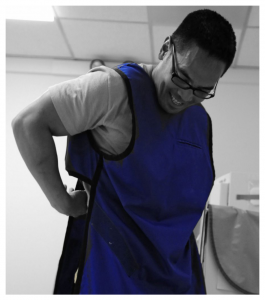
RADIATION PROTECTION

Can you see it? No
Can you smell it? No
Can you feel it? No
Can you taste it? No
Almost everyone on our planet is exposed to radiation on a daily basis. It is a natural phenomenon. Most people are surprised to learn about sources of radiation they are exposed to each day, such as:
• microwaves used in your kitchen
• smartphones
• naturally grown foods (nuts, bananas, and beer are commonly consumed items that contain potassium 40, which is radioactive)
• your home (tile, granite countertops, and some basements contain radioactive materials)
• smoke alarms
• kitty litter (made from clay or bentonite contains uranium and thorium)
• jewelry (some gemstones are naturally radioactive like zircon, and others are irradiated before you purchase them to enhance their appearance)
• cigarettes (stems from the fertilizer used to grow the tobacco)
Typically, none of these items produce enough harmful radiation (except for the cigarettes) to adversely impact humans. If however, you’re employed in a field that leverages radiation on a daily basis for diagnostic/therapy purposes, or if you’re a patient recipient of radiation for diagnostic (x-ray) or therapy (treatments), you should ensure that you are wearing something to shield yourself from potential scatter radiation which may emit levels high enough to impact your health adversely.
Protective lead (and other radiation barrier materials) aprons and other garments are a long-standing necessary staple within clinics that provide radiation services to patients. iRad recommends protective aprons be available and worn by all patients receiving radiation (x-rays or radiation therapy) in a clinical setting and in some states, the law requires it.
iRad provides a broad range of radiation protective garments such as aprons, vests, thyroid collars, gloves/mitts, eyewear, shields, positioning sandbags, racks, and hangers.
Many products now allow you to select whether you’d like your apparel to be:
• full lead (most economical)
• TL light (20% lighter than full lead and 100% recyclable)
• Non-leaded (25% lighter than full lead, flexible, and environmentally friendly)
For those who wear shielding gear on a regular basis, one of these alternative options may provide some relief from wearing heavy full lead aprons. In addition to the material composition, you’ll have several choices of shell material, patterns, and colors.
iRad would like to highlight the importance of establishing regular apron inspections within your facility to ensure that the protective elements of your gear remain intact. Over time protective gear can wear and become ineffective in protecting from radiation. Proper care and storage of your apparel when not in use will lengthen the effective lifespan of your products. While some states articulate specific intervals by which clinics must inspect their protective wear, iRad reccomends establishing a rhythm of inspecting all radiation protective apparel every 6 months. We also suggest each unit be marked for reference and a log maintained and updated with the date and the individual who performed the inspection.
Kind Words From Some of Our Clients
“For years I had looked for a consultant to help with our Radiation Documentation and Compliance. My quest was answered with a true gem. Natalie Stroik previously worked for the Texas Radiation Department and has now started her own private consulting service. She came into our office and totally and completely updated our radiation compliance forms and records. She is affordable and complete. Or record keeping and documentation is now totally compliant and up to date…and the Texas Department of Radiation does do random unannounced inspections. I am 100% certain that most offices would benefit from her services. She is just that good!”
